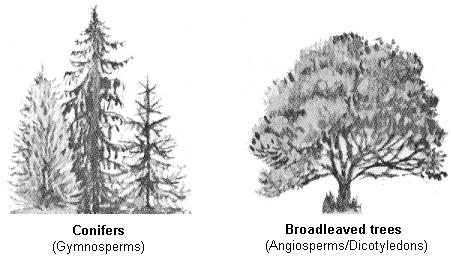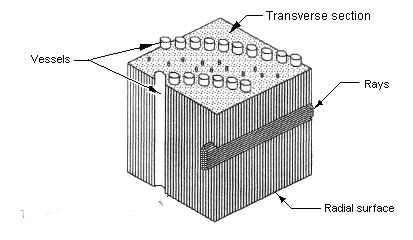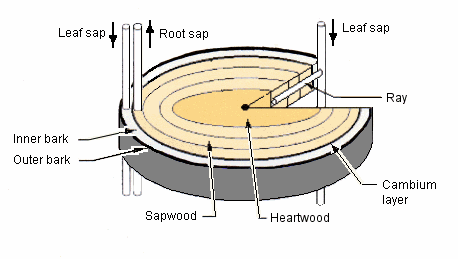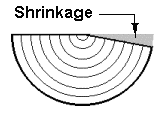The Woodturner's Workshop
Home
Home
WoodTreesIn order to appreciate the properties of wood it is worthwhile knowing something about the trees from whence it comes. Trees are members of a division of the Plant kingdom known as Spermatophyta (seed bearing plants). This is divided into two classes: Gymnospermae (conifers) and Angiospermae (flowering plants). The distinction between them is that the conifers have naked seeds whereas those of flowering plants are enclosed in a protective case that forms the fruit. Flowering plants have two sub-classes - Dicotyledons and Monocotyledons. Broadleafed trees are found among the dicotyledons, there are no trees amongst the monocotyledons. 
Figure 1: Classes of trees There is a convention that the Conifers are classified as softwoods and the broadleafed trees as hardwoods. This leads to some apparent anomalies, certain 'hardwoods' may be soft and some 'softwoods' may be relatively hard. Thus balsa wood is classified as a hardwood whereas yew is classified as a softwood. Another point is that many English hardwoods are nowhere near as hard as many of the tropical hardwoods. In the past some writers, such as Holtzapffel, have referred to English hardwoods as softwoods. In biological terms trees are classified into a considerable number of different families which are not necessarily closely related. Moreover, some are more closely related to other plants than they are to other trees. Thus, for example, laburnums belongs to the pea family, the strawberry tree to the heather family, and rowans and fruit trees (among others) belong to the rose family. Furthermore, the conifers evolved hundreds of millions of years earlier than the broad-leafed trees. See Chart for more details (in pdf format) These differences affect the appearance and properties of the wood from the various species. Nevertheless, trees have anatomical structures and growth mechanisms that are very similar and unlike those of other plants. These characteristics of trees are described below. Growth of the tree At the beginning of the growing season buds situated on the tip of every branch of the tree initiate activity in the cambium. The cambium is a microscopically thin layer of cells which forms a sheath over the whole tree. By division of its cells it forms new bark on the outside and new sapwood on the inside. Once formed the size of the cells in the new wood do not change - the growth in the height of a the tree is produced by the development of the apical buds and the growth in girth is due to the addition of layers of cells to the sapwood. 
Figure 2: Annual growth increments starting with the first year In a transverse section of the trunk of a tree the annual increments of growth can often be apparent as a series of rings. This is because the cells which are laid down towards the end of the season (the latewood) tend to be smaller and have thicker walls than those formed earlier (the earlywood). 
Figure 3: Transverse section of trunk Because of the pattern of growth described above the trunk tends to be tapered upwards to form a cone. In some species, however, this effect can be masked because the width of the rings higher-up the trunk increases in successive seasons. The result is that a cylindrical form is created. The cellular structure of wood Wood is composed of a mass of cells held together with a substance called lignin. The cells vary in size and shape. Generally they are longer than they are wide and have a central cavity. Softwoods are composed mainly of two types of cell. The most numerous are tracheids which are long and thin, and are aligned with the stem and branch axis. The others are rays that are aligned in a radial pattern. The rays are many cells deep but often only one cell wide. Both of these types of cell are difficult to see with the naked eye. Tracheids can sometimes be 100 times as long as they are wide. Those formed at the beginning of the growth season ('early' or 'spring wood') are larger in diameter and have thinner walls than those formed later in the year (the 'late wood'). The growing season may be extensive and in such cases the boundary between the early and late wood can be abrupt. This difference can show very clearly making the growth rings highly visible. In the example shown in Figure 4 the growth rings were 8 mm wide 
Figure 4: Growth rings in a softwood Hardwoods have a more complicated structure and have three main types of cells: vessels, fibres and rays. Vessels, which have thin walls, are usually many times larger in diameter than fibres. The latter have thick walls with a very small central cavity. These two types of cell have specialised functions: the vessels carry the sap and the fibres give strength to support the tree. The way they are arranged can vary considerably from one species of tree to another. 
Figure 5: Schematic diagram of the structure of a ring porous hardwood In some woods, known as 'ring porous', the vessels are concentrated in the early wood whilst in others (known as 'diffuse porous') they are spread uniformly across the growth ring. The vessels in ring porous woods tend to be larger vessels than those in diffuse porous woods. However, some of the tropical woods among the latter, such as mahogany, have quite large vessels. 
Figure 6: Transverse sections of ring porous woods In Figure 6 the lighter lines running diagonally are the rays. It can be seen that in oak they are particularly pronounced. The sap A living tree contains sap. The sap is mostly water but it contains the essential nutrients that feed the tree. The sap is drawn up from the roots, travels up through the sapwood to the leaves, and flows back down through the inner bark. When the root sap enters the leaves some of the water evaporates but by the process of photosynthesis, in which chlorophyll acts as a catalyst, the remainder combines with carbon dioxide from the air to produce a sugar solution. The leaf sap, now containing sugar and the other nutrients brought up from the roots is carried down the inner bark to feed the production of new cells in the cambium layer. Some of the nutrients are also stored in the rays and other cells to help to sustain the trees life forces. 
Figure 7: Sap flow The heartwood As trees age the older wood in the centre dies and no longer conducts sap. The proportion of heartwood to sapwood tends to be constant within a particular species but the proportions vary between species. The heartwood in softwoods tends to be drier than the sapwood but in hard woods there is usually little difference. The substances in the cells of the heartwood are subject to change. The loss of starch, in particular, makes it less attractive to attack from fungi and insects and it becomes more durable. In many species the heartwood becomes darker than the softwood but the pattern may be irregular. Such changes tend to give the heartwood a more attractive appearance. In some species this is very marked. Drying and shrinkage A living tree contains a considerable amount of sap. The sap is mostly water. In some species the weight of the water is more than twice the weight of the wood. Most of the water is held in the central cavity of the cell but some permeates the walls. The water in the central cavity is the 'free water' which circulates the tree. When the tree is felled and sawn into slabs the wood begins to dry out. First it loses the free water and then the water in the cell walls. When the walls of the cells begin to dry out they start to shrink. The cells shrink more tangentially than they do radially so the greatest shrinkage takes place around the annual rings. Because the greatest shrinkage takes place around the annual rings stresses are created in the wood. The effect of these stresses are most severe in pieces of 'round' wood (that is to say sections of limbs or trunks in the natural state) and frequently the result is that 'V' shaped splits open out (see figure 8). 
Figure 8: Drying splits in 'round' wood If a section of round wood is cut in half whilst it is stll wet this will relieve the stresses but the wood will still shrink and distort as it dries (see Figure 9). 
Figure 9: Shrinkage a half-section of round wood When a tree is sawn into boards the most common method is to cut the tree 'through and through' into parallel slices (sometimes abbreviated into 'thro and thro'). The form taken by the annual rings changes according to how far the slab is from the centre of the tree. 
Figure 10: Sections of a tree sawn through and through If the board nearest to the middle of the tree in Figure 10 is examined it can be seen that at the centre there is an area where the annual rings form full half-circles. When shrinkage takes place around these rings there is a good chance that the wood will bend at that point into a slight 'V' shape (see Figure 2.3). On either side of this central area the slab contains only small sections of the annual rings. Figure 11: Result of shrinkage of board cut from centre of log The farther the annual rings are from the centre of the log they are the angle at which they lie in relation to the surface of the slab gets closer and closer to 90 degrees. So when these short sections of the annual rings shrink, the board may get a little thinner but that is all. Figure 12 is a photograph of part of a board that has been cut from near the centre of the log. The effect described above is clearly shown. Figure 12: Result of shrinkage in actual board cut near centre of a log This can be compared with a slab that is cut farther from the centre of the tree (see Figure 13). Here the board contains much longer sections of the annual rings. When these shrink the result is that the slab forms into a gentle curve. (See Figure 4.6) Even at the edge of the slab the annual rings lie at a large angle to the edges of the board. 
Figure 13: The effect of shrinkage on a board cut from the outer part of the log Of course it is not only boards that are affected by shrinkage. Figure 14 shows how various other sections of timber are affected. The nature of the distortion depends on where the item has been cut from the log and thus the position of the sections of the annual rings. 
Figure 14: Distortion of various sections of timber caused by shrinkage Source: The Encyclopedia of Wood, Published by Forest Products Laboratory, USA The fact that the material they are using shrinks and distorts as it dries has serious implications for many woodworkers. Awareness of this is particularly important for those involved in projects where boards must remain flat or parts must continue to fit together. Because of this it is important for woodturners to know the answer to the question: "How dry is my wood". |